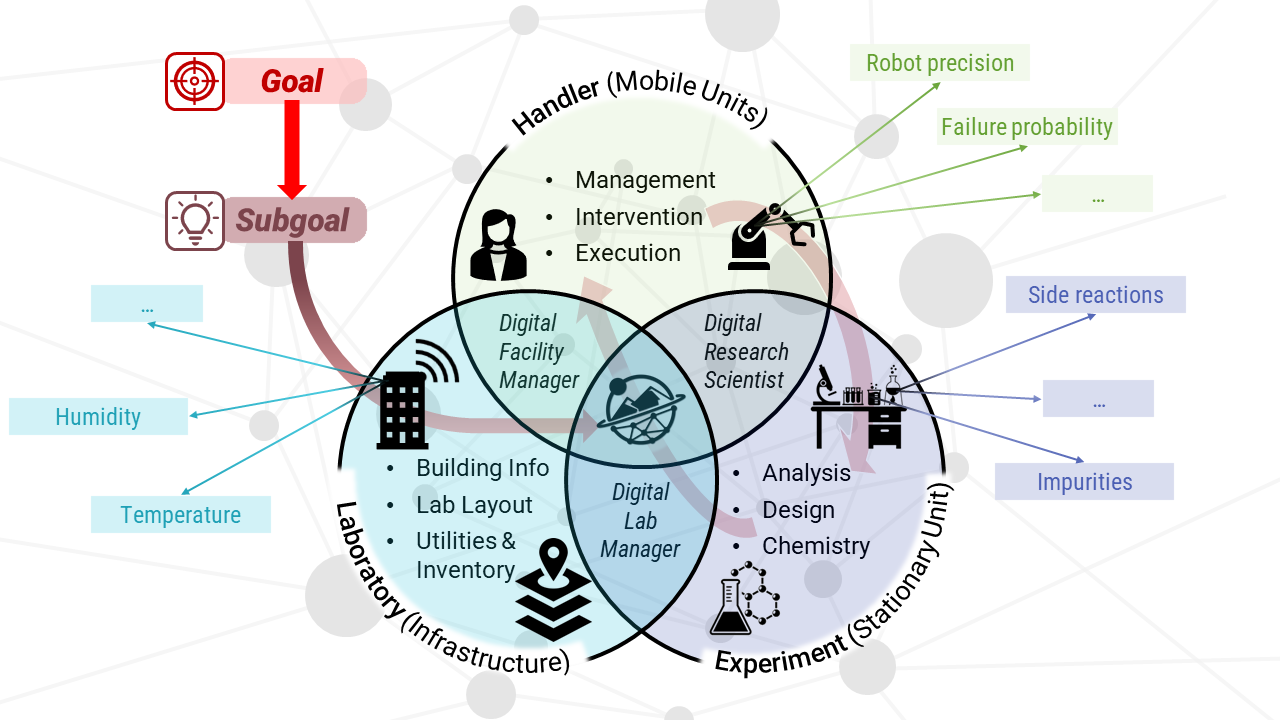Technical Report 314, c4e-Preprint Series, Cambridge
The Digital Lab Framework as part of The World Avatar
Reference: Technical Report 314, c4e-Preprint Series, Cambridge, 2023
- A holistic lab framework pushes a paradigm shift to include all aspects of experimental research.
- Dynamic knowledge graph technology enables connected lab digital twins.
- A systems engineering approach allows for goal-driven self-driving labs.
 In order to tackle many of humanity’s most pressing challenges, scientific discovery needs to be substantially accelerated. The automation of experimental research activities plays a big role in this, from ubiquitous software tools to "self-driving laboratories". Recently, the idea of an "AI scientist" that can make Nobel-worthy discoveries has been introduced in this context. We argue, that current platform-based approaches are insufficient and might even limit further development. Therefore, we introduce the digital lab framework as a holistic approach to laboratory automation. Its hierarchical and semantic structure allows for deep knowledge representation across different domains and scales which is necessary to further interoperability by widening the search and optimisation space to include managerial tasks in research labs as well as information on infrastructure and buildings. This way we can ensure cost effectiveness, improve reproducibility, and bridge the "interim technology gap". To address common challenges related to interoperability and adaptability, this framework is developed as part of "The World Avatar" ecosystem, based on interconnected dynamic knowledge graphs. Viewing at the challenges at hand from a systems engineering perspective, we aim to integrate all aspects of lab work and its automation, contrasting the many isolated solutions available that – amongst others – increase the risk of manufacturer lock-in. The goal-driven architecture enables subsequent design of experiments, and optimal resource distribution according to freely definable research goals.
In order to tackle many of humanity’s most pressing challenges, scientific discovery needs to be substantially accelerated. The automation of experimental research activities plays a big role in this, from ubiquitous software tools to "self-driving laboratories". Recently, the idea of an "AI scientist" that can make Nobel-worthy discoveries has been introduced in this context. We argue, that current platform-based approaches are insufficient and might even limit further development. Therefore, we introduce the digital lab framework as a holistic approach to laboratory automation. Its hierarchical and semantic structure allows for deep knowledge representation across different domains and scales which is necessary to further interoperability by widening the search and optimisation space to include managerial tasks in research labs as well as information on infrastructure and buildings. This way we can ensure cost effectiveness, improve reproducibility, and bridge the "interim technology gap". To address common challenges related to interoperability and adaptability, this framework is developed as part of "The World Avatar" ecosystem, based on interconnected dynamic knowledge graphs. Viewing at the challenges at hand from a systems engineering perspective, we aim to integrate all aspects of lab work and its automation, contrasting the many isolated solutions available that – amongst others – increase the risk of manufacturer lock-in. The goal-driven architecture enables subsequent design of experiments, and optimal resource distribution according to freely definable research goals.
Material from this preprint has been published in Nexus.
PDF (13.9 MB)



